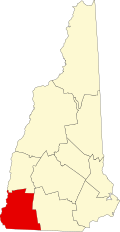The Luke Richardson House is a historic house at 204 Hancock Road in Dublin, New Hampshire. Built about 1820, it is a good local example of a mid-19th century farmhouse with modest Greek Revival features. It was listed on the National Register of Historic Places in 1983.[1]
Description and history
The Luke Richardson House stands in a rural setting in eastern Dublin, on the south side of Hancock Road (New Hampshire Route 137) about 1 mile (1.6 km) north of its junction with New Hampshire Route 101. It is a 2+1⁄2-story wood-frame structure, with a gabled roof and clapboarded exterior. It has an unusually narrow profile, with a two-bay front facade. A single-story porch extends across the front and along one side. An early 20th-century barn stands nearby on the property.[2]
The house was built c. 1820 by Luke Richardson, son of early settler Abijah Richardson, Sr, whose early homestead stands nearby. Luke Richardson operated a gristmill and sawmill on a nearby property, and was instrumental in establishing a Trinitarian Congregational church in Dublin in 1827. Later owners include Charles F. Appleton, who built a hydroelectric facility on Wilder Brook and provided Dublin with its first electric service, and artist Tom Blackwell, who used the barn on the property as his studio.[2]
See also
- Abijah Richardson Sr. Homestead
- Deacon Abijah Richardson House
- John Richardson Homestead
- National Register of Historic Places listings in Cheshire County, New Hampshire
References
- ^ a b "National Register Information System". National Register of Historic Places. National Park Service. July 9, 2010.
- ^ a b "NRHP nomination for Luke Richardson House". National Park Service. Retrieved May 1, 2014.










You must be logged in to post a comment.